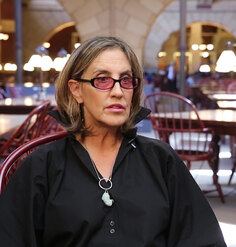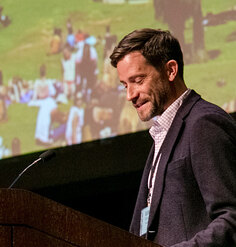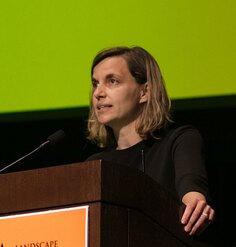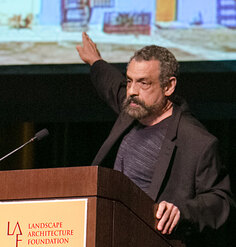Connecting Humans and Nature for an Ideal Future
By Feng Han
This presentation was part of the Landscape Architecture Foundation’s The New Landscape Declaration: A Summit on Landscape Architecture and the Future held in Philadelphia on June 10-11, 2016. LAF asked a diverse group of leading minds to write a “Declaration” reflecting on the last half century and offering bold ideas for how landscape architecture can make its vital contribution in response to the challenges of our time.
Feng Han
Professor, Tongii University
Shanghai, China
Feng Han, Ph.D., is professor and director of the Department of Landscape Studies, College of Architecture and Urban Planning, Tongii University, Shanghai, China. She received both her BLA and MLA from Tongii University and her Ph.D. from Queensland University of Technology in Australia.
Connecting Humans and Nature for an Ideal Future
by Feng Han
"Mountains and rivers are texts on the desktop while texts are mountains and rivers on the desktop."
This old Chinese saying reflects Eastern thought that all human knowledge and achievements were inspired by nature and nature exists everywhere in human life.
Deeply rooted in nature, landscape architecture deals with human-nature interaction through landscape design and construction. Today, not every country provides landscape architecture as a field of study, and not every language has a word for landscape. However, every nation has a view of nature dating to ancient times, each with unique beliefs, wisdom, knowledge, and emotions inspired by nature. The resulting ideals and aspirations are brought into daily work and life through landscapes. Based on this connection, the discipline of landscape architecture bridges all of us to several basic understandings from past to future.
First, landscape is the representation of a view of nature. Landscape reveals human values and views of nature based on the deep-seated philosophical core of the human-nature relationship. Although we have only one objective nature, the view of nature varies by culture. Different cultural and ethnic groups show their understanding of the wisdom of nature through their own cultural filters, which drives us to innovate in the living environment. This, in turn, reflects the global diversity of the spirit and practice of landscape, making a dialogue about landscape possible among different cultural and ethnic groups.
Second, landscape is a treasured heritage of the combined work of humans and nature. Landscape embraces the wisdom of nature, creates worldly ideals, shows respect for life forms other than humans, and exercises ethics and wisdom in living in harmony with other life forms. Landscape is humanistic as well as scientific. A variety of landscapes express long and intimate relationships between people and their natural environment, reflect specific techniques of land use that guarantee and sustain biological diversity, and embody the spiritual relationship of people and nature associated in the minds of the communities with powerful beliefs and artistic and traditional customs. Landscapes are a treasured human legacy for sustainable development for future.
Third, the meaning of landscape is socially constructed. Landscape is socially constructed, so it has a layering of meanings associated with the social subjects of construction, the construction process itself, and the cultural input process, which has great social relevance to beliefs, knowledge, and the use of nature by the authors and communities. Landscape is a social container and space to reflect deep social values, relationships, emotions, and memories.
These core values of landscapes face unexpected threats, especially because of intensified globalization and urbanization. Environmental degradation, increasing social conflicts, and the loss of harmonious human-nature relationships, local identity, and historical context become significant topics of concern for the future. Landscape architecture should play a role in advocating a historical and evolutionary holistic methodology and approach and thereby lead the way in the overall development of the built environment of the future. The relationships that humans have with nature, contested landscape, cultural landscape diversity, natural values, heritage landscape conservation, and sustainable landscape approaches and tools are key issues that need to be addressed.
Rebuild a sustainable relationship between humans and nature with a sense of urgency. Accelerating urbanization, disorderly urban expansion, and the exploitation of natural resources have exacerbated the divide between humans and nature. Pollution, smog, and food insecurity threaten the necessities people need to survive. The relationship between humans and nature has reached a critical point. Environmental philosophy should be applied to the landscape architecture framework. Only in this way can our attitudes toward nature be fundamentally changed and sustainable development improved. Science cannot save us from the root.
Focus on contested landscapes and create social equity in landscape. The reorganization of social spaces and population migration accompanied by globalization and urbanization are, in essence, the redistribution of natural resources and land resources. In this process, we must consider land tradition, emotions, memory, and interest. We must face contested social spaces and ensure that the new landscape becomes traditional inheritance and sustainable development, recognizing social welfare and justice instead of social and capital privilege. Landscape architects should be more socially responsible.
Reinforce understanding and sustaining landscape as cultural habitat. Each landscape is not empty. It has its own stories and history. Involving local communities, recognizing and respecting their cultural customs, and using both innovative and traditional practices can provide more effective management and governance of multifunctional landscapes, contributing to their resilience and adaptability and enhancing local identity. Landscape creation should keep cultural responsibility and historical context in mind while acknowledging individual innovations.
Enhance understanding of intrinsic natural values and respect for nature. Nature speaks its own languages. Strengthening interdisciplinary scientific work in landscape, enhancing our knowledge of the intrinsic values of nature, and taking concrete actions in urban and rural development to conserve and interpret natural values are the keys to maintaining harmony between humans and nature. Implementing this core task of landscape for a sustainable built environment is a win-win strategy for humans and nature in sustainable coexistence.
Protect and manage landscape heritage. A bright future can be ensured only by knowing the past. Landscape heritage embodies the wisdom of people who know nature and land in a particular natural environment, their spiritual pursuit, emotional memory, and cultural identity. All are valued treasures of human society. Effective protection and management of heritage provide a great engine for future development. We must ensure that we remember where we came from and can recognize the way home even while we move into the future.
Develop strategies and tools for sustainable landscape planning and design. There is an urgent demand in landscape architecture education and training to provide multidisciplinary knowledge and solutions. Concrete planning and design strategies, approaches, and tools that can integrate economic, social, cultural, and environmental processes inclusively for sustainable development are strongly advocated.
Our objective is not just to live intelligently and healthily but also to live on earth spiritually and politically together with all other forms of life. This is the ambitious task for future landscape architects.











